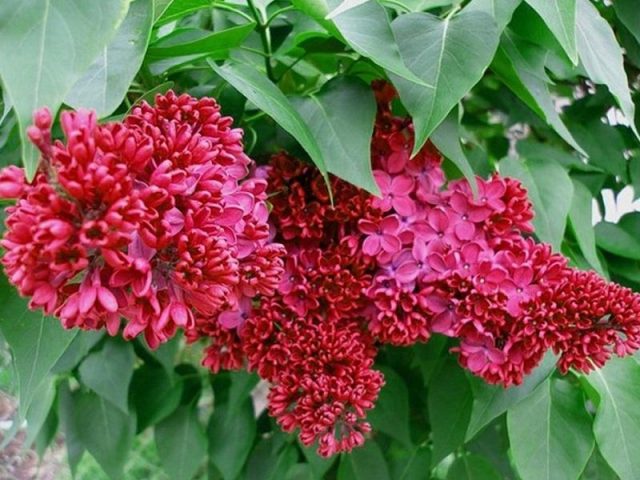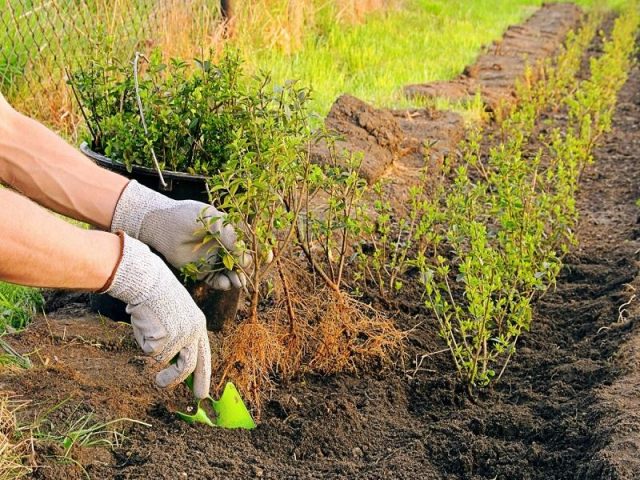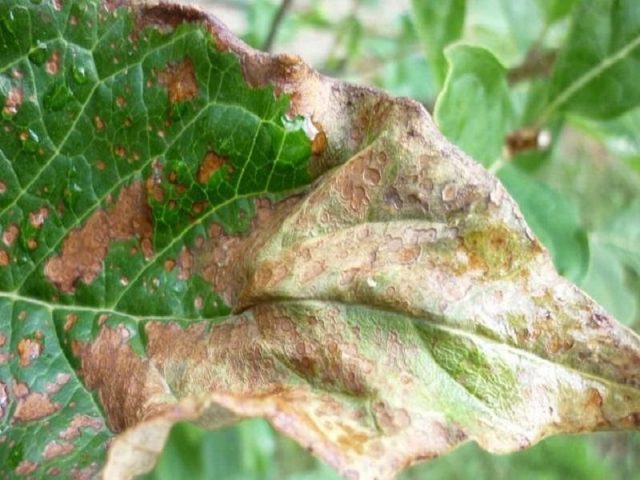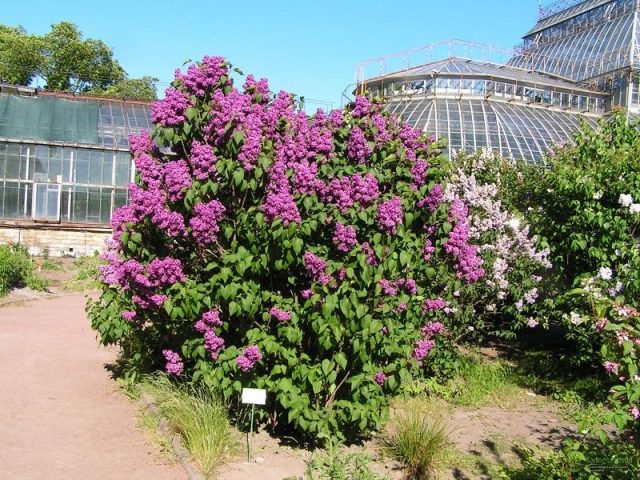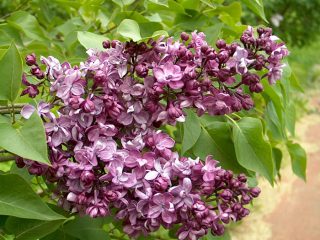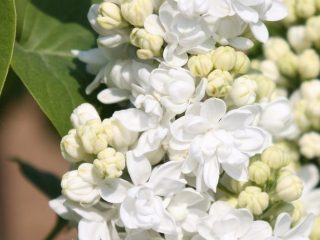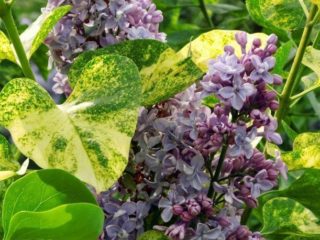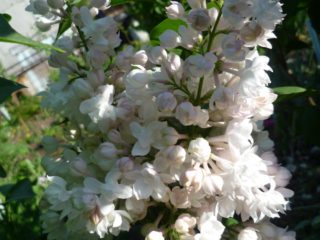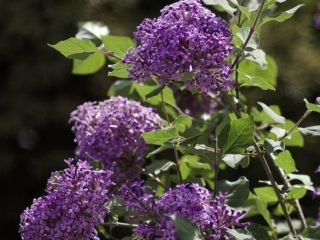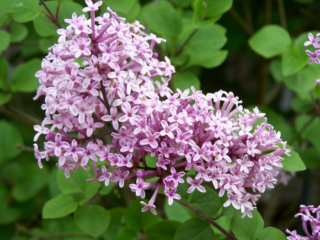Content
Red Moscow lilac is a charming garden decoration that has been winning the hearts of flower growers for many decades. The variety is a real masterpiece of breeder L. A. Kolesnikov.
Lilacs have always been loved in Russia. And today she is at the peak of popularity. It is planted in parks, squares, garden plots, and dachas. It's hard to imagine a spring garden without fragrant lilac bushes. Despite the unpretentiousness of the plant, planting and care should be carried out correctly so that flowering is annual and abundant.
Description of the lilac variety Red Moscow
Common lilac Red Moscow is an ornamental deciduous shrub with a spreading crown. It reaches a height of 4 m, a width of 3 m. It is formed from wide, strong shoots of gray color. The annual growth of the bush is 20 cm.
The leaves of the plant are opposite, entire, heart-shaped, dark green. They remain like this until the leaves fall in late autumn.
Flowering begins in May. The buds of the Red Moscow lilac are violet-purple. The flowers are large and turn bright purple as they bloom. In their center are bright yellow stamens.The petals are rounded, with slightly raised edges. The inflorescences are large panicles, very dense, slightly ribbed. Their size is 9 by 18 cm. The color has a strong lilac aroma.
According to the description and photo, the Red Moscow lilac variety has a remarkable feature - it is resistant to fading in the sun, despite the dark color of the petals.
The shrub is unpretentious to grow. Prefers sunny places, fertile soils and the absence of close groundwater.
Winter hardiness of Red Moscow is very high. The crop is weakly susceptible to diseases and pests.
Reproduction methods
Several methods are used to propagate varietal lilacs:
- cuttings;
- layering;
- vaccination;
- own root shoots.
According to reviews, the Red Moscow lilac is difficult to propagate by cuttings due to poor rooting. Planting material is harvested during or after flowering. Cuttings are cut in the morning from young bushes, from the center of the crown. A part of the shoot with short internodes and two nodes is suitable for this purpose. Next you need to perform a number of operations:
- Remove leaves from the bottom of the cutting.
- Make an oblique cut closer to the bottom node.
- Cut the remaining leaves by half.
- Make a straight cut above the top knot.
- Soak the cuttings in a growth stimulator solution for 12 hours.
- Plant them (up to the first node) in a container with a mixture of sand and peat, cover with polyethylene and shade.
- Plantings should be opened and sprayed with water periodically.
- After 2 months, when the cuttings have roots, they should be transplanted into a separate bed for growing.
Breeding by layering is as follows:
- Around the Red Moscow lilac bush, make grooves 2 cm deep.
- Annual shoots are placed in furrows and fixed in several places.
- Then cover with a layer of loose soil.
- The shoots are spudded several times during the summer.
- In the fall, rooted cuttings are cut off from the mother plant and placed for growing.
- After 3 years they are transferred to a permanent place.
Reproduction by grafting is a rather complicated method. For this purpose, shoots of the current year are used, from which all leaves are removed. Cuttings should have one or two nodes. They are grafted onto the bark: tied with plastic wrap, the cut is treated with garden varnish, and the cutting is covered with a bag. If the grafting is done correctly, after 2 weeks the buds begin to develop.
The most reliable way to propagate Red Moscow lilacs is by root shoots. The best time for this is the period of swelling of the kidneys. The seedlings take root well and take root until the shoots grow.
Planting and care
When planting the ornamental lilac crop Red Moscow, several rules must be followed:
- deadlines;
- choosing the right soil structure;
- careful selection of the location of the bush;
- excluding the possibility of placing the plant in a wet or waterlogged area.
The place for lilacs should be sunny and well lit. The shrub grows in the shade, but its flowering is not particularly lush.
Red Moscow feels good on poor soil, but on fertile and loose soil with a neutral reaction, it does much better.
Caring for the plant is simple: you need to water it on time, using up to 3 buckets of water for one adult bush, loosen the soil, removing weeds, and feed it.
When to plant
Red Moscow lilac seedlings can be planted at different times.
Spring planting is extremely unreliable, since it is necessary to do it before the buds awaken. We have to hurry because... Even before the snow completely melts, the buds begin to grow. Flower growers who leave reviews about the common lilac Red Moscow note that in the spring it takes root poorly and even after rooting it looks stunted and weak.
The most suitable time for planting is August-September. During this period, the plant stops vegetation and sap flow: the seedling has time to take root and prepare for wintering.
In late autumn, it is better to bury the plant in a secluded place until spring.
An unacceptable time for planting is the flowering period of the Red Moscow lilac. Adaptation will take a long time, but the result is not guaranteed.
Site selection and soil preparation
The best place for ornamental shrubs is well-lit, protected from cold, strong winds. Low, swampy or temporarily flooded places in autumn or spring are not suitable at all. Stagnation of water leads to rotting and death of roots.
The soil for Red Moscow lilacs should contain a large amount of humus, be of medium humidity, fertile, and loose.
If it is poor in content, it is worth feeding with organic matter or fertilizers. Sandy soils are strengthened by adding black soil or alumina. Clayey ones are lightened with peat or leaf humus. If the soil is highly acidic, periodic application of ash, dolomite flour, and slaked lime is recommended.
How to plant
Based on the experience of gardeners and the presented photos, Red Moscow lilac bushes are planted in a selected area at a distance of 3 m from each other. The size of the planting hole depends on the characteristics of the soil. On fertile soil, its size should be no more than 50x50x50 cm. On poor soil - 100x100x100 cm. Humus or compost, ash and superphosphate are added to such a pit. The components are mixed. Planting is carried out in cloudy weather or in the evening. A Red Moscow lilac seedling must have a well-developed root system and crown. After shortening the roots that are too long, it is placed in the center of the planting hole and, having evenly distributed the roots, it is covered with substrate. The plant should be watered and the soil mulched with peat.
Rules of care
Planting a Red Moscow seedling is completed by watering it. After water is absorbed into the soil, the tree trunk circle is mulched with peat, rotted leaves, and humus. The thickness of the layer is 7 cm. Loosening is carried out at least 4 times per season to a depth of no more than 7 cm. Fertilizing with nitrogen begins in the second year. Organic fertilizers and ash are effective.
Watering the plant should be frequent during shoot growth, flowering, and in hot weather.
Pruning of the Red Moscow lilac begins in the third year of the bush’s life, since before that it grows slowly. The goal is to form skeletal branches. Early in the spring, before the buds awaken, 5 to 10 good shoots are found near the bush, well and beautifully located, and the rest are removed. To prepare young plants for winter, additionally mulch the soil underneath them, bringing the layer to 15 cm.
Diseases and pests
The Red Moscow lilac variety is resistant to diseases and pests. Under unfavorable climatic conditions and poor agricultural practices, the plant can be affected by a number of pathologies:
- milky sheen: when cavities appear under the skin of the leaf, giving it a silvery tint;
- spotting: patterns appear on the leaf blades, which lead to their withering;
- late blight: the buds do not bloom, turn black and dry out;
- bacterial shoot rot: spots appear on the shoots, leading to rotting of the bark;
- mosaic: yellowing, curling and drying of leaves is observed;
- necrosis: which manifests itself in wet weather by wilting of the tips of the shoots.
Disease control measures include removing and destroying affected branches and spraying with Bordeaux mixture.
The most dangerous pests of the Red Moscow lilac variety include:
- apple scale;
- lilac moth;
- kidney mite;
- corrosive woody wood;
- leaf cutter bee.
Pest control involves loosening the soil near the bush, treating it with insecticides, and attracting insectivorous birds to the site.
Application in landscape design
The beauty of the Red Moscow variety and unpretentiousness in caring for lilacs allow the shrub to be used in creating a modern landscape. The crop can be shaped like a tree or left in its natural shrub form.
It looks great both in single plantings and in group plantings; it looks good next to coniferous plants, but gets lost near fruit and forest trees.
From the Red Moscow lilac you can create magnificent hedges, alleys and entire gardens.
Traditionally, it is planted near gazebos, benches, and windows of houses in order to enjoy not only its appearance, but also the aroma of flowers.
Conclusion
Red Moscow lilac is a bright, beautiful variety of domestic selection, one of the world's seven best inflorescences with a purple color. Growing a shrub is not difficult, its care is minimal, and the impressions of flowering are indescribable. Once you plant a lilac bush on your site, you can admire its appearance and enjoy its aroma all your life.
Reviews
